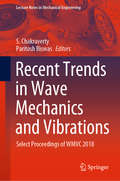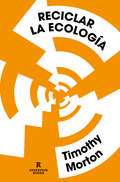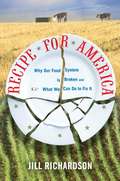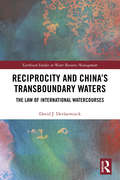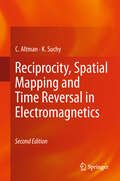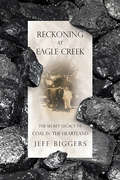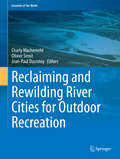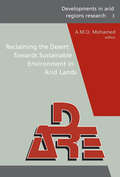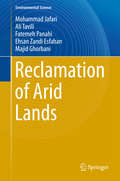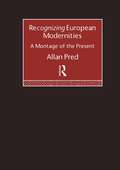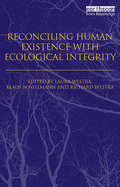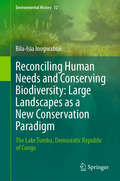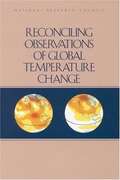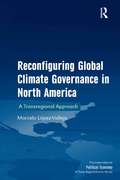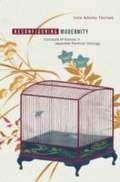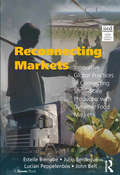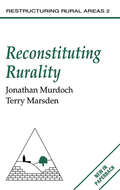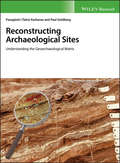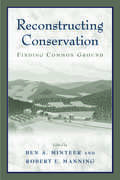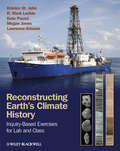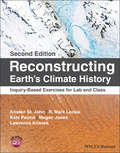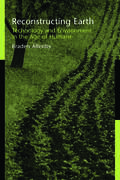- Table View
- List View
Recent Trends in Wave Mechanics and Vibrations: Select Proceedings of WMVC 2018 (Lecture Notes in Mechanical Engineering)
by S. Chakraverty Paritosh BiswasThis book consists of select proceedings of the National Conference on Wave Mechanics and Vibrations (WMVC 2018). It covers recent developments and cutting-edge methods in wave mechanics and vibrations applied to a wide range of engineering problems. The book presents analytical and computational studies in structural mechanics, seismology and earthquake engineering, mechanical engineering, aeronautics, robotics and nuclear engineering among others. This book can be useful for students, researchers, and professionals interested in the wide-ranging applications of wave mechanics and vibrations.
Reciclar la ecología: Pensar el mundo tras el fin de la naturaleza
by Timothy MortonPor fin un libro sobre ecología que no es un vertedero de información, ni un billete hacia el sentimiento de culpa, ni un sermón a la masa aborregada. ¿No te importa la ecología? Eso es lo que crees. ¿No lees libros de ecología? Este libro es para ti. Este ensayo tiene la intención de darle la vuelta a la ecología y enseñarnos a pensar en ella cuando la naturaleza ha desaparecido. De nada sirve ya la manera actual de entenderla, repleta de pseudodatos que confunden e instalada en el «¿qué será de nosotros?». En el corazón de este ambicioso ensayo hay una crítica radical a la distancia científica con que reflexionamos sobre nuestro entorno: el mundo solo puede ser captado si lo experimentamos. Lo que nos abruma no es el fin de la naturaleza sino los prejuicios sobre el lugar que deberían ocupar los humanos en el mundo. Morton lanza un torpedo a la línea de flotación de la arrogancia antropocentrista mediante analogías memorables entre Kant y Star Wars, Blade Runner, letras de los Talking Heads o el budismo tibetano. No se trata de construir una sociedad más amable con el medioambiente, se trata de cambiar el paradigma de nuestra relación con el mundo. La crítica ha dicho...«Leo desde hace años los libros de Tim y debo decir que me encantan.»Björk «Un ecologista que se preocupa de asuntos estructurales en vez de regañarte por no separar el plástico de la basura orgánica.»Ernesto Castro «Leer a Morton es quedar atrapado en un brillante despliegue de pirotecnia intelectual.»The Guardian «Morton hace un esfuerzo notable para extender el género filosófico hasta territorios apetecibles para una amplia variedad de lectores. En vez de intentar; de manera angustiante; someter a validación todas las estrategias infructuosas del activismo o de las políticas medioambientales (que él considera un esfuerzo fútil en un mundo tan cambiante como el nuestro); Morton nos abre la puerta; casi nos da permiso; para abrazar lo incierto.»Massive «Una guía imprescindible y muy alternativa para vivir ecológicamente; por uno de nuestros filósofos más eminentes. Muy útil para todo aquel que quiera entender mejor cuál es nuestra relación con la biosfera. Lo que propone Morton es saber vivir una vida con sentido en una era incierta; la nuestra.»Jeff VanderMeer «Si aún piensas que la naturaleza mola y es guay; piensa otra vez. La ontología plana de Timothy Morton [...] desmonta muchos clichés adquiridos y abre nuevas posibilidades para concebir un futuro mejor juntos. Reciclar la ecología lo logra; además; promoviendo la discusión en un tono estimulante y muy libresco.»Nick Montfort; catedrático de Digital Media del MIT y autor de The Future
Recipe for America
by Jill Richardson"Jill Richardson is a fresh voice in the movement to create a healthier and sustainable food system. This book will be part of the burgeoning food social movement, as it provides a guide to the most important issues and how to work on them."--Marion Nestle"Jill's work at Daily Kos represents the best of the people-powered movement. It's a pleasure to see her work reach a new plateau and come to the attention of a wider audience."--Markos MoulitsasAmerica's food system is dominated by agribusiness and corporate farms, whose destructive practices pollute the environment, are cruel to animals, and offer us unhealthy food choices. Despite this dire situation, most people have little idea how to eat differently, or healthier.In Recipe for America, food activist Jill Richardson shows how sustainable agriculture--where local farms raise food that is healthy for consumers and animals and does not damage the environment--offers the only solution to America's food crisis. In addition to highlighting the harmful conditions at factory farms, this timely and necessary book details the rising grassroots food movement, which is creating an agricultural system that allows people to eat sustainably, locally, and seasonally.A call to action for those who are concerned about what they eat and the health of the planet, Recipe for America shows how sustainable eating nourishes our bodies, our economy, and our environment, and how it is the best hope for the future of food in America.Jill Richardson blogs about food issues at Daily Kos and at her own blog, La Vida Locavore (http://www.lavidalocavore.org). She is also a member of the advisory board of the Organic Consumers Association.
Reciprocity and China’s Transboundary Waters: The Law of International Watercourses (Earthscan Studies in Water Resource Management)
by David J. DevlaeminckUtilizing the principle of reciprocity, Reciprocity and China’s Transboundary Waters: The Law of International Watercourses analyses the past, present and future of the law of international watercourses with a particular focus on China. As a legal principle, reciprocity plays a strong role in the formation, interpretation and maintenance of international law. Implementing this framework, the book examines the development of the law of international watercourses, highlighting how this basic legal principle is a foundational notion. It applies the framework to China and offers insights into one of the most important transboundary states in Asia. As a primarily upstream state, China is of great significance to its transboundary neighbours; however, there remain significant hurdles, misunderstandings and mistrust between China and its neighbours. China is faced with a complex challenge - how to meet its own development needs while also taking into consideration its primarily downstream neighbours? By focusing on this prominent state this work not only fosters a greater understanding of the law of international watercourses within China, but also clarifies and challenges current perceptions of China’s transboundary water treaty practice. More generally, the book provides a past, present and future view on international watercourse law, starting with an analysis of the UN Watercourses Convention and UNECE Water Convention leading to a discussion of reciprocity’s continued influence as well as charting a path forward. This book will be of great interest to legal students and scholars with an interest in international watercourses, environmental politics and international law, as well as students and scholars interested in Chinese politics and natural resource management and conflict.
Reciprocity, Spatial Mapping and Time Reversal in Electromagnetics
by C. Altman K. SuchyThis long awaited second edition traces the original developments from the 1970s and brings them up to date with new and previously unpublished material to give this work a new lease of life for the early twenty-first century and readers new to the topic. In the winter of 1970-71, Colman Altman had been finding almost exact symmetries in the computed reflection and transmission matrices for plane-stratified magnetoplasmas when symmetrically related directions of incidence were compared. At the suggestion of Kurt Suchy the complex conjugate wave fields, used to construct the eigenmode amplitudes via the mean Poynting flux densities, were replaced by the adjoint wave fields that would propagate in a medium with transposed constitutive tensors, to yield a scattering theorem - reciprocity in k-space -- in the computer output. To prove the result analytically, one had to investigate the properties of the adjoint Maxwell system, and the two independent proofs that followed, in 1975 and 1979, proceeded according to the personal preference of each of the authors. The proof given in this volume, based on the hindsight provided by later results, is much more simple and concise. Later, when media with bianisotropic constitutive tensors were investigated, it was found that conjugate (reciprocal) media and wave fields could be formed by any orthogonal spatial mapping of those in the original problem, after media and fields were reversed in time. The result was still quite general and not limited to stratified systems. The second line of development was to find the link between reciprocity in k-space and Lorentz reciprocity involving currents and sources in physical space. This was done for plane-stratified media by applying the scattering theorem to the plane-wave spectrum of eigenmodes radiated by one current source and reaching the second source. The reverse linkage between Lorentz reciprocity and reciprocity in k-space had already been found. However, this was the first time that the results were presented in a systematic and mathematically well-defined procedure to serve as a tool for solving problems of reciprocity and scattering symmetries. The use of time reversal gives rise to problems of causality when sources are present, but when the interaction between two systems is involved the non-causal effects are irrelevant. The insight gained during these investigations enabled the authors to present many of the earlier theorems and results, both their own and those of others, in a compact and unified approach, which has been the main strength of this book. This new edition has been revised, corrected and updated where necessary to give a complete picture of this interesting topic for the present generation of scientists.
Reckoning at Eagle Creek: The Secret Legacy of Coal in the Heartland (Shawnee Bks.)
by Jeff BiggersCultural historian Jeff Biggers takes us to the dark amphitheatre ruins of his family’s nearly 200-year-old hillside homestead that has been strip-mined on the edge of the first federally recognized Wilderness Site in southern Illinois. In doing so, he not only comes to grips with his own denied backwoods heritage, but also chronicles a dark and missing chapter in the American experience: the historical nightmare of coal outside of Appalachia, serving as an exposé of a secret legacy of shame and resiliency.
Reclaiming and Rewilding River Cities for Outdoor Recreation (Estuaries of the World)
by Olivier Sirost Jean-Paul Ducrotoy Charly MachemehlThe introduction of sports and recreational facilities into natural environments calls for reflection on their impact on fragile ecosystems. This book is unique in providing an interdisciplinary approach to the ecological restoration of urban and industrial degraded habitats and their use by nearby city-dwellers. For the first time ecologists, sociologists and anthropologists have worked together on particularly sensitive ecosystems such as rivers and estuaries to propose recovery strategies that allow their basic ecological functions to be restored, and which can benefit local populations through nature activities.Nonetheless, the use of natural spaces calls for the building of sustainable towns. This is why this book is distinctive in considering quality of life and well-being as stated objectives of modern river towns. Recently, leisure time has become a part of urban rhythms. In order to favour personal development, an extensive palette of leisure activities is considered by the authors:bird watchingentertainmentsportscultureMany aspects including physical and psychological attributes in relation to the contemporary socio-political fabric are dealt with.While creating areas of freedom, landscaping also induces certain forms of practice and encourages certain social skills. Conversely, the book questions certain types of management based on mass consumption. Don’t they, in the end, aim to satisfy needs that are impermanent and shallow? The image of the contemporary town relies on urban planning projects which, in a global economy, seek to capture the interest of tourists and local populations. How can suitable, diligent planning be successfully combined with both creative design and ecological care? This book demonstrates how biology and sociology can (and should) work in harmony in order to promote an ecosystem approach to environmental management.
Reclaiming the Desert: Proceedings of the Third Joint UAE-Japan Symposium on Sustainable GCC Environment and Water Resources (EWR2006), 30 January - 1 February 2006, Abu Dhabi, UAE.
by A.M.O. MohamedA comprehensive collection of contributions from the Middle East and Japan, dealing with pressing problems concerning sustainability in arid zones, this time with the accent on environmental science and engineering. The symposium brought together researchers and field engineers who discussed issues such as sulphur utilization in agriculture and con
Reclaiming the Don
by Jennifer L. BonnellA small river in a big city, the Don River Valley is often overlooked when it comes to explaining Toronto's growth. With Reclaiming the Don, Jennifer L. Bonnell unearths the missing story of the relationship between the river, the valley, and the city, from the establishment of the town of York in the 1790s to the construction of the Don Valley Parkway in the 1960s. Demonstrating how mosquito-ridden lowlands, frequent floods, and over-burdened municipal waterways shaped the city's development, Reclaiming the Don illuminates the impact of the valley as a physical and conceptual place on Toronto's development.Bonnell explains how for more than two centuries the Don has served as a source of raw materials, a sink for wastes, and a place of refuge for people pushed to the edges of society, as well as the site of numerous improvement schemes that have attempted to harness the river and its valley to build a prosperous metropolis. Exploring the interrelationship between urban residents and their natural environments, she shows how successive generations of Toronto residents have imagined the Don as an opportunity, a refuge, and an eyesore. Combining extensive research with in-depth analysis, Reclaiming the Don will be a must-read for anyone interested in the history of Toronto's development.
Reclamation of Arid Lands (Environmental Science and Engineering)
by Mohammad Jafari Ali Tavili Fatemeh Panahi Ehsan Zandi Esfahan Majid GhorbaniThis book provides an overview of arid and semi-arid lands conditions, their general characteristics, methods of management, conservation, exploitation and reclamation. It also focuses on how to utilize the potential of arid lands with the minimum manipulation and alteration. Arid and semi-arid areas represent a major part of natural ecosystems not only in Iran, but around the world, and mismanagement and inappropriate exploitation of these areas may lead to further gradual degradation. As such, an understanding of the characteristics of these areas is vital if they are to be conserved and reclaimed.
Recognising European Modernities: A Montage of the Present
by Allan PredFirst published in 1995. Routledge is an imprint of Taylor & Francis, an informa company.
Reconciling Human Existence with Ecological Integrity: Science, Ethics, Economics and Law
by Laura Westra Richard Westra Klaus Bosselmann'The ecological challenge demands a paradigm shift in our thinking about the human-environment relation. Reconciling Human Existence with Ecological Integrity provides a ‘state of the art account of work on ecological integrity - and offers a compelling vision for the future. Derek Bell, Senior Lecturer at the School of Geography, Politics and Sociology, University of Newcastle A book of vast scope and richness ... If policymakers around the world took notice of this insightful set of messages, we would all live with greater happiness, health, and wellbeing, with a brighter future for our children and grandchildren. Lawrence O. Gostin, O‘Neill Professor of Global Health Law, Georgetown University Law Center This book attempts to do in theory what the world needs to do in practice. It is an ecological master plan that shows how we can not only survive but also flourish. James P. Sterba, President of the American Philosophical Association, Central Division Ecosystems have been compared to a house of cards: remove or damage a part and you risk destroying or fundamentally and irreversibly altering the whole. Protecting ecological integrity means maintaining that whole - an aim which is increasingly difficult to achieve given the ever-growing dominance of humanity. This book is the definitive examination of the state of the field now, and the way things may (and must) develop in the future. Written and edited by members of the Global Ecological Integrity Group - an international collection of the worlds most respected authorities in the area - the book considers the extent to which human rights (such as the rights to food, energy, health, clean air or water) can be reconciled with the principles of ecological integrity. The issue is approached from a variety of economic, legal, ethical and ecological standpoints, providing an essential resource for researchers, students and those in government or business in a wide range of disciplines.
Reconciling Human Needs and Conserving Biodiversity: The Lake Tumba, Democratic Republic of Congo (Environmental History #12)
by Bila-Isia InogwabiniProtected areas have often been defined as the backbones of biodiversity conservation. Protected areas have often been defined as the backbones of biodiversity conservation. However, legitimate demands formulated by countries for their economic development, growing human populations, forest fragmentations, and needs of local communities for sustainable livelihoods are also pressing demands on protected areas, stringently pressuring conservation community to identify means to reconcile long term biodiversity conservation and communities’ livelihoods. Hence, integrating conservation activities within the global framework of economic development of countries with high biodiversity had become part of conservation paradigms. Integrated development as a route to conservation, strict protected areas, community managed areas, etc. have been tried but resulted in debatable outcomes in many ways. The lukewarm nature of these results brought ‘landscape approach’ at the front of biodiversity conservation in Central Africa. Since the late 1990s the landscape approach uses large areas with different functional attributes and shifts foundational biodiversity conservation paradigms. Changes are brought to the role traditionally attributed to local communities, aligning sustainable development with conservation and stretching conservation beyond the confines of traditional protected areas. These three shifts need a holistic approach to respond to different conservation questions. There are only a few instances where the landscape experience has been scientifically documented and lessons learnt drawn into a corpus of knowledge to guide future conservation initiatives across Central Africa. To subjugate one biodiversity conservation landscape as one case study emerged as a matter of urgency to present the potential knowledge acquired throughout the landscape experiment, including leadership and management, processes tried, results (at least partially) achieved, and why such and such other process or management arrangement were been chosen among many other alternatives, etc. The challenges of the implementation of the conservation landscape approach needed also to be documented. This book responds to the majority of these questions; drawing its content from the firsthand field knowledge, it discusses these shifts and documents what has been tried, how successful (unsuccessful) it was, and what lessons learnt from these trials. Theoretical questions such as threat index, and ecological services, etc. are also discussed and gaps in knowledge are identified.
Reconciling Observations of Global Temperature Change
by Panel on Reconciling Temperature ObservationsThe National Academies Press (NAP)--publisher for the National Academies--publishes more than 200 books a year offering the most authoritative views, definitive information, and groundbreaking recommendations on a wide range of topics in science, engineering, and health. Our books are unique in that they are authored by the nation's leading experts in every scientific field.
Reconfiguring Global Climate Governance in North America: A Transregional Approach (The International Political Economy of New Regionalisms Series)
by Marcela Lopez-VallejoGlobal climate governance has presented problems that have led to failures, yet it has also opened the door to new transregional governance schemes, especially in North America. This book introduces an environmental dimension into the concept of governance. Almost fifteen years after the climate global governance concept emerged, results worldwide have not been as favorable as expected. This book details previous discussions about the concept of global climate governance and its limits. It highlights how the Kyoto Protocol has a limited design taking into account a national approach to global, regional, and transnational problems, had no obligatory mechanisms for implementation and explains the emergence of new polluters not committed under it such as China and India. Furthermore this book explores other levels of authority such as regional institutions - the North American agreement on trade (NAFTA) and on environment (NAAEC), as well as the regional energy working group (NAEWG). The author puts forward a theoretical proposal for re-territorialization and coordination of policies for climate change into new forms of articulating interests in what she terms transnational green economic regions (TGERs) and tests this on two case studies - the Regional Greenhouse Gas Initiative (RGGI) and the Western Climate Initiative (WCI). This study presents the challenges and opportunities of a transregional approach in North America.
Reconfiguring Global Societies in the Pre-Vaccination Phase of the COVID-19 Pandemic
by Jack FongReconfiguring Global Societies in the Pre-Vaccination Phase of the COVID-19 Pandemic examines lived experiences of the COVID-19 pandemic in communities and societies around the world before the arrival of vaccines. This collection presents analyses of scholars from eight countries, all of whom were engaged in the unfolding crisis of social forces across the world. This timely volume conveys valuable insights about how public officials, the state, healthcare workers, and, ultimately, citizens responded to consequences of the pandemic upon not only the body but also social relations in community, city, and society. The contributing scholars document how state apparatuses, urban configurations, places of employment, legal structures, and ways of life responded to crisis-altered social conditions during the pandemic. The book investigates what societies experiencing crisis around the world reveal about the state’s efficacy and inefficacy in fulfilling its social contract for its citizens, especially on unresolved issues related to social relations based on politics, race, ethnicity, gender, and crime. This collection brings together a cross section of scholars experiencing the same temporal moment of crisis together, watching and observing how the pandemic of their age uncoiled itself into the fabric of community, onto the institutions and bureaucracies of society, and into the most intimate confines of the home.
Reconfiguring Modernity: Concepts of Nature in Japanese Political Ideology
by Julia Adeney ThomasA study of changing Japanese understandings of "nature" from the mid-19th century to the early 20th century.
Reconnecting Markets: Innovative Global Practices in Connecting Small-Scale Producers with Dynamic Food Markets (Gower Sustainable Food Chains Series)
by Estelle Biénabe Julio Berdegué John BeltThe rapid changes taking place in the structure and governance of national and regional agri-food markets in developing countries seriously affect the ability of agriculture, especially small-scale agriculture, to contribute to economic growth and sustainable development. Reconnecting Markets is the second volume of case examples from the Regoverning Markets programme (2005-2008). It focuses on the keys to inclusion of small-scale farmers and rural SMEs into dynamic national and regional markets. The cases document specific arrangements that appear to have played a positive role in supporting greater inclusion, such as public policies and business initiatives, collective action by farmers and support from development agencies.
Reconstituting Rurality
by Jonathan Murdoch Terry MarsdenThe second in the "Restructuring Rural Areas" series, this work presents an examination of the way in which the rural, and the concept of rurality is being reconstructed within urban regions.; It argues that the rural is not a fixed category but the outcome of political, economic and socio- cultural pressures. These pressures are exacerbated in southeast England - an area dominated by London and the patterns of growth associated with that city. Through close analysis of key land development processes and a series of village studies, the authors give a forceful demonstration of the way in which certain social groups are becoming increasingly influential in determining the material and social shape of rural areas in the United Kingdom. The formation of class identity, it is argued, is closely bound up with the formation of certain local spaces; class and space must be considered as combined elements in the development of rural locales. To illustrate this the authors document in detail the means by which dominant groups represent themselves within the development process and show how the exclusion of certain kinds of development leads to the exclusion of certain social groups.
Reconstructing Archaeological Sites: Understanding the Geoarchaeological Matrix
by Paul Goldberg Panagiotis KarkanasA guide to the systematic understanding of the geoarchaeological matrix Reconstructing Archaeological Sites offers an important text that puts the focus on basic theoretical and practical aspects of depositional processes in an archaeological site. It contains an in-depth discussion on the role of stratigraphy that helps determine how deposits are organised in time and space. The authors — two experts in the field — include the information needed to help recognise depositional systems, processes and stratigraphic units that aid in the interpreting the stratigraphy and deposits of a site in the field. The book is filled with practical tools, numerous illustrative examples, drawings and photos as well as compelling descriptions that help visualise depositional processes and clarify how these build the stratigraphy of a site. Based on the authors’ years of experience, the book offers a holistic approach to the study of archaeological deposits that spans the broad fundamental aspects to the smallest details. This important guide: Offers information and principles for interpreting natural and anthropogenic sediments and physical processes in sites Provides a framework for reconstructing the history of a deposit and the site Outlines the fundamental principles of site formation processes Explores common misconceptions about what constitutes a deposit Presents a different approach for investigating archaeological stratigraphy based on sedimentary principles Written for archaeologists and geoarchaeologists at all levels of expertise as well as senior level researchers, Reconstructing Archaeological Sites offers a guide to the theory and practice of how stratigraphy is produced and how deposits can be organised in time and space.
Reconstructing Conservation: Finding Common Ground
by Ben A. Minteer Robert E. ManningIn the 1990s, influenced by the deconstructionist movement in literary theory and trends toward revisionist history, a cadre of academics and historians led by William Cronon began raising provocative questions about ideas of wilderness and the commitments and strategies of the contemporary environmental movement. While these critiques challenged some cherished and widely held beliefs -- and raised the hackles of many in the environmental community -- they also stimulated an important and potentially transformative debate about the conceptual foundations of environmentalism.Reconstructing Conservation makes a vital contribution to that debate, bringing together 23 leading scholars and practitioners -- including J. Baird Callicott, Susan Flader, Richard Judd, Curt Meine, Bryan Norton, and Paul B. Thompson -- to examine the classical conservation tradition and its value to contemporary environmentalism. Focusing not just on the tensions that have marked the deconstructivist debate over wilderness and environmentalism, the book represents a larger and ultimately more constructive and hopeful discussion over the proper course of future conservation scholarship and action.Essays provide a fresh look at conservation icons such as George Perkins Marsh and Aldo Leopold, as well as the contributions of lesser-known figures including Lewis Mumford, Benton MacKaye, and Scott Nearing. Represented are a wealth of diverse perspectives, addressing such topics as wilderness and protected areas, cultural landscapes, rural/agrarian landscapes, urban/built environments, and multiple points on the geographic map. Contributors offer enthusiastic endorsements of pluralism in conservation values and goals along with cautionary tales about the dangers of fragmentation and atomism. The final chapter brings together the major insights, arguments, and proposals contained in the individual contributions, synthesizing them into a dozen broad-ranging principles designed to guide the study and practice of conservation.Reconstructing Conservation assesses the meaning and relevance of our conservation inheritance in the 21st century, and represents a conceptually integrated vision for reconsidering conservation thought and practice to meet the needs and circumstances of a new, post-deconstructivist era.
Reconstructing Earth's Climate History
by Lawrence Krissek Kate Pound R. Mark Leckie Megan Jones Kristen St JohnThe context for understanding global climate change today lies in the records of Earth's past. This is demonstrated by decades of paleoclimate research by scientists in organizations such as the Integrated Ocean Drilling Program (IODP), the Antarctic Geological Drilling Program (ANDRILL), and many others.The purpose of this full colour textbook is to put key data and published case studies of past climate change at your fingertips, so that you can experience the nature of paleoclimate reconstruction.Using foundational geologic concepts, students explore a wide variety of topics, including: marine sediments, age determination, stable isotope paleoclimate proxies, Cenozoic climate change, climate cycles, polar climates, and abrupt warming and cooling events, students are invited to evaluate published scientific data, practice developing and testing hypotheses, and infer the broader implications of scientific results.It is our philosophy that addressing how we know is as important as addressing what we know about past climate change. Making climate change science accessible is the goal of this book.This book is intended for earth science students at a variety of levels studying paleoclimatology, oceanography, Quaternary science, or earth-system science.Additional resources for this book can be found at: http://www.wiley.com/go/stjohn/climatehistory.
Reconstructing Earth's Climate History: Inquiry-Based Exercises for Lab and Class
by Lawrence Krissek Kate Pound R. Mark Leckie Megan Jones Kristen St. JohnReconstructing Earth’s Climate History There has never been a more critical time for students to understand the record of Earth’s climate history, as well as the relevance of that history to understanding Earth’s present and likely future climate. There also has never been a more critical time for students, as well as the public-at-large, to understand how we know, as much as what we know, in science. This book addresses these needs by placing you, the student, at the center of learning. In this book, you will actively use inquiry-based explorations of authentic scientific data to develop skills that are essential in all disciplines: making observations, developing and testing hypotheses, reaching conclusions based on the available data, recognizing and acknowledging uncertainty in scientific data and scientific conclusions, and communicating your results to others.The context for understanding global climate change today lies in the records of Earth’s past, as preserved in archives such as sediments and sedimentary rocks on land and on the seafloor, as well as glacial ice, corals, speleothems, and tree rings. These archives have been studied for decades by geoscientists and paleoclimatologists. Much like detectives, these researchers work to reconstruct what happened in the past, as well as when and how it happened, based on the often-incomplete and indirect records of those events preserved in these archives. This book uses guided-inquiry to build your knowledge of foundational concepts needed to interpret such archives. Foundational concepts include: interpreting the environmental meaning of sediment composition, determining ages of geologic materials and events (supported by a new section on radiometric dating), and understanding the role of CO2 in Earth’s climate system, among others. Next, this book provides the opportunity for you to apply your foundational knowledge to a collection of paleoclimate case studies. The case studies consider: long-term climate trends, climate cycles, major and/or abrupt episodes of global climate change, and polar paleoclimates. New sections on sea level change in the past and future, climate change and life, and climate change and civilization expand the book’s examination of the causes and effects of Earth’s climate history.In using this book, we hope you gain new knowledge, new skills, and greater confidence in making sense of the causes and consequences of climate change. Our goal is that science becomes more accessible to you. Enjoy the challenge and the reward of working with scientific data and results! Reconstructing Earth’s Climate History, Second Edition, is an essential purchase for geoscience students at a variety of levels studying paleoclimatology, paleoceanography, oceanography, historical geology, global change, Quaternary science and Earth-system science.
Reconstructing Earth: Technology and Environment in the Age of Humans
by Braden AllenbyThe Earth's biological, chemical, and physical systems are increasingly shaped by the activities of one species-ours. In our decisions about everything from manufacturing technologies to restaurant menus, the health of the planet has become a product of human choice. Environmentalism, however, has largely failed to adapt to this new reality.Reconstructing Earth offers seven essays that explore ways of developing a new, more sophisticated approach to the environment that replaces the fantasy of recovering pristine landscapes with a more grounded viewpoint that can foster a better relationship between humans and the planet. Braden Allenby, a lawyer with degrees in both engineering and environmental studies, explains the importance of technological choice, and how that factor is far more significant in shaping our environment (in ways both desirable and not) than environmental controls. Drawing on his varied background and experience in both academia and the corporate world, he describes the emerging field of "earth systems engineering and management," which offers an integrated approach to understanding and managing complex human/natural systems that can serve as a basis for crafting better, more lasting solutions to widespread environmental problems.Reconstructing Earth not only critiques dysfunctional elements of current environmentalism but establishes a foundation for future environmental management and progress, one built on an understanding of technological evolution and the cultural systems that support modern technologies. Taken together, the essays offer an important means of developing an environmentalism that is robust and realistic enough to address the urgent realities of our planet.
Reconstructing Human-Landscape Interactions - Volume 1
by Aileen C. Elliott Nalini Torres Brett T. MclaurinThe Holocene is unique when compared to earlier geological time in that humans begin to alter and manipulate the natural environment to their own needs. Domestication of crops and animals and the resultant intensification of agriculture lead to profound changes in the impact humans have on the environment. Conversely, as human populations began to increase geologic and climatic factors begin to have a greater impact on civilizations. To understand and reconstruct the complex interplay between humans and the environment over the past ten thousand years requires examination of multiple differing but interconnected aspects of the environment and involves geomorphology, paleoecology, geoarchaeology and paleoclimatology. These Springer Briefs volumes examine the dynamic interplay between humans and the natural environment as reconstructed by the many and varied sub-fields of the Earth Sciences.
